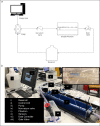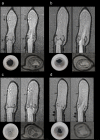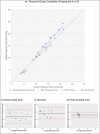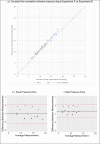Aortic Stenosis: Haemodynamic Benchmark and Metric Reliability Study
- PMID: 36745287
- PMCID: PMC10480252
- DOI: 10.1007/s12265-022-10350-w
Aortic Stenosis: Haemodynamic Benchmark and Metric Reliability Study
Abstract
Aortic stenosis is a condition which is fatal if left untreated. Novel quantitative imaging techniques which better characterise transvalvular pressure drops are being developed but require refinement and validation. A customisable and cost-effective workbench valve phantom circuit capable of replicating valve mechanics and pathology was created. The reproducibility and relationship of differing haemodynamic metrics were assessed from ground truth pressure data alongside imaging compatibility. The phantom met the requirements to capture ground truth pressure data alongside ultrasound and magnetic resonance image compatibility. The reproducibility was successfully tested. The robustness of three different pressure drop metrics was assessed: whilst the peak and net pressure drops provide a robust assessment of the stenotic burden in our phantom, the peak-to-peak pressure drop is a metric that is confounded by non-valvular factors such as wave reflection. The peak-to-peak pressure drop is a metric that should be reconsidered in clinical practice. The left panel shows manufacture of low cost, functional valves. The central section demonstrates circuit layout, representative MRI and US images alongside gross valve morphologies. The right panel shows the different pressure drop metrics that were assessed for reproducibility.
Keywords: 3D printing; Aortic stenosis; Aortic valve; Haemodynamics.
© 2023. The Author(s).
Conflict of interest statement
The authors declare no competing interests.
Figures







Similar articles
-
Non-invasive cardiovascular magnetic resonance assessment of pressure recovery distance after aortic valve stenosis.J Cardiovasc Magn Reson. 2023 Jan 30;25(1):5. doi: 10.1186/s12968-023-00914-3. J Cardiovasc Magn Reson. 2023. PMID: 36717885 Free PMC article.
-
Blood speckle imaging compared with conventional Doppler ultrasound for transvalvular pressure drop estimation in an aortic flow phantom.Cardiovasc Ultrasound. 2022 Jul 16;20(1):18. doi: 10.1186/s12947-022-00286-1. Cardiovasc Ultrasound. 2022. PMID: 35840940 Free PMC article.
-
Estimation of valvular resistance of segmented aortic valves using computational fluid dynamics.J Biomech. 2019 Sep 20;94:49-58. doi: 10.1016/j.jbiomech.2019.07.010. Epub 2019 Jul 17. J Biomech. 2019. PMID: 31358285
-
Is cardiac magnetic resonance imaging as accurate as echocardiography in the assessment of aortic valve stenosis?Interact Cardiovasc Thorac Surg. 2016 Apr;22(4):480-6. doi: 10.1093/icvts/ivv362. Epub 2015 Dec 30. Interact Cardiovasc Thorac Surg. 2016. PMID: 26718319 Review.
-
Contemporary Imaging of Aortic Stenosis.Heart Lung Circ. 2019 Sep;28(9):1310-1319. doi: 10.1016/j.hlc.2019.05.177. Epub 2019 Jun 12. Heart Lung Circ. 2019. PMID: 31266725 Review.
References
-
- Vahanian A, Beyersdorf F, Praz F, Milojevic M, Baldus S, Bauersachs J, Wojakowski W. 2021 ESC/EACTS Guidelines for the management of valvular heart disease developed by the task force for the management of valvular heart disease of the European Society of Cardiology (ESC) and the European Association for Cardio-Thoracic Surgery (EACTS) European Heart Journal. 2021 doi: 10.1093/EURHEARTJ/EHAB395. - DOI - PubMed
-
- Otto, C. M., Nishimura, R. A., Bonow, R. O., Carabello, B. A., Iii, J. P. E., Krieger, E. v, Toly, C. (2021). 2020 ACC/AHA guideline for the management of patients with valvular heart disease. 10.1161/CIR.0000000000000923 - PubMed
Publication types
MeSH terms
Grants and funding
LinkOut - more resources
Full Text Sources
Miscellaneous

